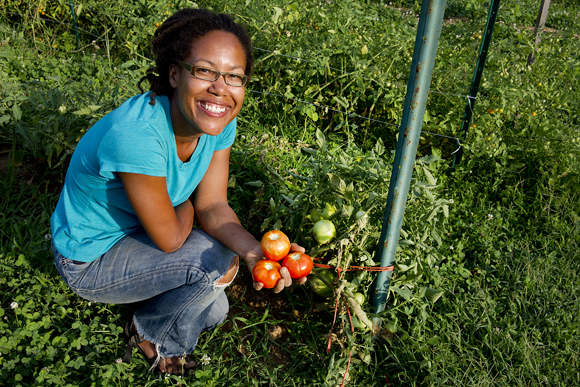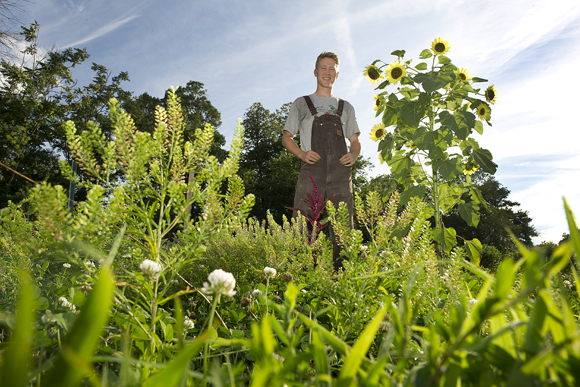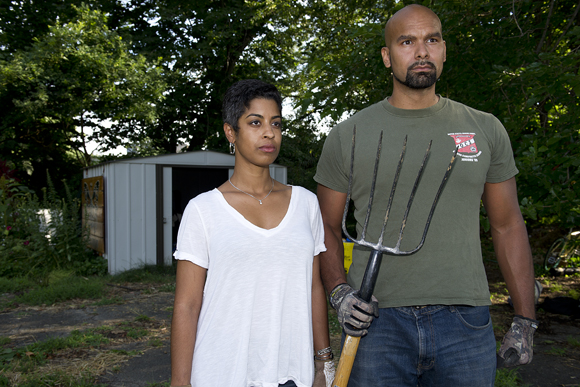Think it's hard to grow food in the city and make money at it? You'd be 100% correct. Still, that hasn't stopped these intrepid farmers from trying--and, in some ways, succeeding.
This time of year, Gail Taylor spends up to 60 hours a week working the soil at one of the five farm plots she manages in the District, but she doesn’t consider herself a full-time farmer.
“I get a break, because I go to my job,” says Taylor, who manages a yoga studio part-time to provide funding for Three Part Harmony Farm. The farm is set up as a for-profit, but Taylor gives away most of the produce she grows on borrowed land to avoid paying steep taxes to the city (about $25,000 per acre on one plot).
She hopes to someday make a living as an urban farmer and is working with District officials on a new bill that could make that more feasible through tax abatements and incentives.

Despite all the buzz about growing food in the city, only a handful of for-profit businesses are doing better than break-even in urban agriculture. The Sustainable DC Act includes a goal of putting 20 additional acres of land in the city under cultivation for growing food in the next couple of decades.
The urban farming models that have proven the most successful here hinge on growing food for individuals or retail outlets on a contract basis — and not having to pay taxes on the land where the food is grown.
But new models continue to emerge, and city officials seem eager to consider how they might build a healthier ecosystem for locally grown food.
The Urban Farming and Food Security Act of 2014, for example, would establish incentives for leasing land to farmers in the city and tax credits for farmers who donate their food to local nonprofits. A 50 percent tax abatement on urban agricultural lands is part of the original bill, but urban farmers voiced concerns through an online forum and at a hearing that it would still not be enough to make their operations financially viable.
As some D.C.-based farming hopefuls wait in the wings for better policies or grow food outside the city, others have forged business models around the unique challenges of urban agriculture.
 Raising roof food
Raising roof food
What D.C. lacks in wide-open spaces it makes up for in rooftops. So Krisof Grina and his business partners at
Up Top Acres decided to farm them.
“The rooftops, I think, are an untapped resource,” says Grina, a D.C. native who is launching the business with two high school friends. “It’s tough to produce a huge amount of food in the city, but there’s a lot of potential to increase the food production we have so far.”
The partners plan to have their first roof under cultivation next spring growing organic fruits, vegetables and mushrooms alongside beehives on leased space. Grina points to similar farming models that have taken root in Boston and New York City, like
Brooklyn Grange Farm.
Up Top Acres plans to “help the business stay profitable” by hosting educational programs and private events on portions of the roofs that aren’t used for growing food.
Grina also hopes the rooftop farms can take advantage of new rebates for green roofs in the city, which pay building owners up to $10 a square foot to grow plants on their roofs that help absorb stormwater runoff.
The city also welcomed with open arms a national company that has built greenhouses on the roofs of grocery stores in other cities.
BrightFarms plans to break ground in July on a 100,000-square-food greenhouse farm in Ward 8 (in a vacant lot, not on a roof, at the corner of South Capitol Street and Southern Avenue). The farm will grow up to 1 million pounds of tomatoes, lettuce, herbs and other crops hydroponically, or in water, and employ as many as 25 people in the process, says spokesman Toby Tiktinsky.
 Fit for the city
Fit for the city
A year before AJ Cooper ran (unsuccessfully) for D.C. City Council in 2012, he bought a 2.5-acre plot in Maryland “that looked like a jungle.” He started conducting agricultural research on the land for projects that would fit well into the D.C. landscape and provide much needed jobs to low-income corners of the city.
Working with grants and researchers from the National Academy of Scientists and climatologists from NASA eventually led Cooper to aquaponics, a method of growing fish and plants together in a recirculating water system. NASA was working to scale the growing methods to fit onto a spacecraft.
“I said, ‘Well, if it can work on Mars, maybe it can work in Southeast,’” Cooper remembers. “Ideally, in the next five years, we’ll have dozens of centers in D.C.”
At
Freedom Farms DC’s research facility in Hyattsville, Md., Cooper has constructed a pilot of what he’d like to build throughout the District and what he’s currently working toward in Takoma Park, Md.
The greenhouse-like facility grows plants like greens, herbs and berries in floating substrate while catfish or koi swimming in separate tanks produce fertilizer for the plants until they’re harvested.
 Ryan Palmer, left, CEO, and AJ Cooper, founder of Freedom Farms doing their "American Gothic" impression
Ryan Palmer, left, CEO, and AJ Cooper, founder of Freedom Farms doing their "American Gothic" impression
But Cooper wants to do more than grow food with the facilities. He aims to employ low-income workers and give them equity in the company after six months on the job. Health and wellness centers will be attached to the growing centers so that the bicycles used in spin classes can help power large batteries to run the greenhouse, supplemented by solar energy. (He’s built a pilot of this facility and says it actually works.)
“Basically, these growing centers are vehicles for communities in crisis to have stability, healthy food — fruits and vegetables and fish — and health and wellness activities. That’s the localized effect of it,” Cooper says.
A food-growing service

Meredith Sheperd, owner of
Love & Carrots, has expanded her business that helps residents launch and maintain edible urban gardens in the District since we last
wrote about her. She now has nine full-time employees and some apprentices tending to some 85 food gardens of varying sizes in and around the city.
That’s not counting the garden owners who have “graduated” from the program and are now maintaining their own, which would add up to nearly 200. Sheperd has decided to cap the number of gardens her crew can maintain at a given time at 100 this year, to keep the logistics more manageable.
She now grows most of her starter plants in a new 1,000-square-foot hoop house on an acre plot she’s acquired, which helps keep costs down.
“I’m not making a killing, but I’m proud of the fact that I created my job, and everyone’s making a livable wage,” says Sheperd, who adds that taxes and insurance are still her biggest costs.
Gail Taylor wants more people to be able to make a living growing food in the District, but she sees herself as providing a public service until then. She is paid to grow some food gardens on residents’ properties, but her main focus is on improving the landscape for small farms in the city.
On a recent afternoon in June, Taylor stopped by her largest plot in the city, a 2-acre swath on Fourth Street Northeast, to water rows of leafy greens while volunteers harvested mustard greens to donate.
Even as she gives away the food grown here, Taylor says she’s planting the seeds for her “future farm,” where she hopes she can grow food to sell for a reasonable price to local residents.
“I hope that as many people as want to farm in the city can,” Taylor says as she leaves the farm on her bike to tend another plot, “that we can grow our own food.”
This article has been updated to clarify some details relating to Freedom Farms' aquaponics project. The fish swim in separate tanks, not directly below the plants, and the Takoma Park project is not yet under construction. Elevation DC regrets the errors.